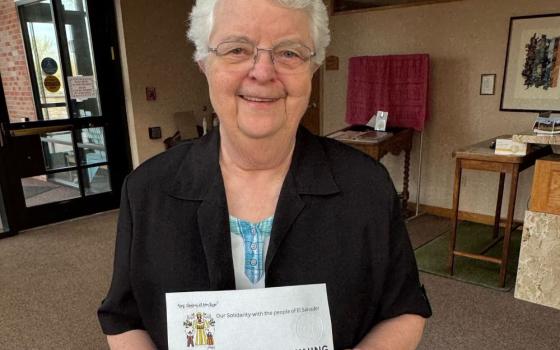In its response to the Congregation for the Doctrine of Faith doctrinal assessment to their organization, the Leadership Conference of Women Religious Aug. 10 issued a statement reflective of its belief that life is a journey, and that if one responds affirmatively to risk-taking in a loving and generous way, albeit within the context of Great Mystery, then one is properly answering a call to participate in God’s plan for humanity and the wider creation process.
At one level, the LCWR response was both practical and tactical. It called for dialogue and by so doing, it avoided a confrontation with the hierarchy, which has been critical of its work. The statement simply absorbs the misunderstanding, pain, violence and abuse the women who gathered here find within the doctrinal assessment. Not unlike a Japanese Jujutsu move that manipulates an opponent's force rather than confronting it with one’s own, the statement asked Archbishop J. Peter Sartain, the apostolic delegate appointed by CDF to oversee LCWR, to move forward with the women in more conversation.
The imagery of a face-off becomes one of a journey walking side by side. At least this is the clear signal the women want to send to Rome. In such imagery the women have said neither “yes” nor “no” to the mandate, which, they point out, is really to this point a mandate delivered to Sartain and not yet to them.
But it says more than, “let’s talk.” It declares a kind of theological positioning with potentially deep ramifications for the discussions and even for the wider church. It says in so many words: “We are on an Alpha – Omega journey, coming out of Divine love and returning into it as co-creative participants.”
The U.S. women religious have slowly come to imagine the hand of God in the very doctrinal assessment that has caused them so much anguish. As misrepresenting as they feel it is in describing the nature, mission and values of LCWR, the women, after much processing, are now seeing it as a kind of “trigger” moment, one that is forcing a uniquely public look at what LCWR is and what it has come to represent. The women do not see themselves operating in opposition to the hierarchy, but rather as a timely, needed pastoral complementary, feminine voice within the church.
Coming after several days of deliberations, the LCWR statement is anchored in an unstated belief in process, of forward movement, and a sense that at this time in history women are being asked by nature itself to lead the way. It is also anchored in a belief in a loving God who not only created the universe, but who also remains active in it, as the Second Vatican Council has taught.
The women see this God Spirit walking among us and before us and calling us forth. Sometimes in our hostile and uninviting world, they seem to say, this requires special courage. The women view this as part of an evolutionary process. And while our common journeys, as experience shows, are fraught with peril, (personal and institutional sin are very much part of our story), the women paint a hopeful picture, one in which women and men of good will can work together on behalf of justice to build the Reign of God on earth.
This vision is a distinctly Catholic sacramental vision growing out of ancient Catholic traditions, more recently contextualized by the writing of the late Jesuit Father Teilhard de Chardin, as well as Passionist Father Thomas Berry and captured in conference talks by the futurist Barbara Marx Hubbard.
It is a vision articulated, in part, in the closing address by then LCWR President Franciscan Sister Pat Farrell to the sisters on the last night of the assembly. She said:
“Many institutions, traditions, and structures seem to be withering. Why? I believe the philosophical underpinnings of the way we’ve organized reality no longer hold. The human family is not served by individualism, patriarchy, a scarcity mentality, or competition. The world is outgrowing the dualistic constructs of superior/inferior, win/lose, good/bad, and domination/submission. Breaking through in their place are equality, communion, collaboration, synchronicity, expansiveness, abundance, wholeness, mutuality, intuitive knowing, and love. This shift, while painful, is good news! It heralds a hopeful future for our Church and our world. As a natural part of evolutionary advance, it in no way negates or undervalues what went before. Nor is there reason to be fearful of the cataclysmic movements of change swirling around us. We only need to recognize the movement, step into the flow, and be carried by it. Indeed, all creation is groaning in one great act of giving birth.”
If process, dialogue and evolution comprise an essential element of the final LCWR response to the CDF, the other is a declarative exclamation about the present time. It is a statement about who these LCWR women religious are now – 50 years after the Second Vatican Council. It is a statement about how they have gotten here – and what they now represent to the church and wider world.
Fundamentally, these women see themselves as communities of hope in a world hungry for authentic spirituality and hope.
These women see themselves as witnesses to the pains and joys of the People of God, especially the most marginalized among them. Why? Because these women have purposely lived among them and ministered to them through their lifetimes. And because the marginalized almost never have the ability to become agents of their own destinies. Their voices are seldom heard. Until now.
What makes these women religious different today is that the corporal works of mercy they have been engaged in faithfully for so many years now have grown to include another kind of feeding – a feeding of the Body of Christ with new vision and new hope, a belief that Jesus is alive among the poor, that attending to the least among us is central to the Christian mission, that answering calls to healing, reconciliation and love are the means to human fulfillment, and that small sparks of hope can ignite into raging fires within our hearts.
Our women religious, represented in the LCWR leadership, recognize more than most the dis-spirited nature of our times. Theirs is an alternative vision. It is a vision that proclaims that Christian communities are intrinsically hopeful, that they believe in the goodness of all people, and that these communities must never stop being living examples of the full embrace and acceptance, which Jesus taught.
Specifically, these women appear to have growing confidence that that the pastoral vision of church that grew out of the Second Vatican Council, a vision that moved them obediently to renew their congregational charters decades back, is, indeed, the church of the future, and that after 50 years this church, in part through them, is coming to fruition. It is a church containing the collective yearnings and aspirations of untold millions of lay Catholics throughout the world, laity these religious women among them.
The women seem to be saying to the Vatican; yes to dialogue – but a dialogue with parameters.
The LCWR assembly also articulated its belief that religious life, as it is being lived by these women religious, is an authentic expression of a life of community and love that must not be compromised.
“The theology, ecclesiology, and spirituality of the Second Vatican Council serve as the foundation of this form of religious life – and while those who live it must always be open to conversion – this life form should not be discounted,” LCWR stated.
So the final LCWR assembly expression does more than call for conversation, more than simply answer the CDF doctrinal assessment. It is also an attempt “to reconcile the differences that exist within the Catholic Church” and create “spaces for honest and open conversation on the critical moral and ethical questions that face the global community.”
In her outgoing address to the assembly, Farrell advised the sisters not to make too much or too little of the doctrinal assessment. Her measured tone allowed the group to see and size it up in a manageable way. This, then, represents one more challenge among many, albeit one from within the church and from the bishops. She then offered six tools “for navigating the shifts occurring in the world and church”: contemplation, use of the prophetic voice, solidarity with the marginalized, community, nonviolent responses, and the capacity to live in joyful hope.
In the world LCRW envisions, the women can discuss the mandate guided by the six tools.
If the women came to Saint Louis full of anxieties, they left buoyed by a collective sigh of a relief they had come to common grounds and that it was filled with the joy and hope of which Farrell spoke. They left believing they had modeled a way of being church that was coming out of consensus, was respectful, nonviolent, avoided demeaning characterizations. It was one that allowed plenty of room in which the bishops could maneuver without having to lose face.
The gathering, meanwhile, reinforced, in the women’s eyes, the pressing need for more feminine voices within our church while offering encouragement that for now, some of these voices had surfaced, and are being listened to throughout the church and beyond.
The LCWR statement insists from the start that the conversation with the bishops must take place “from a stance of deep prayer that values mutual respect, careful listening and open dialogue.”
And how long do the women envision these conversations will last?
As long as required, unless LCWR “is forced to compromise the integrity of its mission … as a voice for justice in the world.”
For the sake of LCWR, the church, and wider world, let’s now pray this integrity will be respected and will remain intact.
[Thomas C. Fox is NCR's publisher. He spoke on a panel at the LCWR assembly titled "Religious life in the future: What might it look like?"]
Previous reports from NCR on the LCWR assembly:
- LCWR will continue dialogue, but not compromise mission, Aug.10
- LCWR president to sisters: Be 'fearless' on Vatican mandate, Aug. 10
- Sisters contemplate surrender, discernment, authority, Aug. 10
- Sister, NCR contributors discuss religious life with LCWR, Aug. 10
- Keynote: LCWR 'seed bed' for 21st century, Aug. 8
- LCWR 'gathers collective wisdom' of members to discern next steps, Aug. 8
- LCWR past presidents reflect on Vatican mandate, Aug. 7
- LCWR to determine course at next week's annual meeting, July 31
For related commentary see:
- The Vatican, LCWR, and Definitions of Dialogue By Kevin Aschenbrenner
- What LCWR teaches us about church leadership By Jamie L. Manson
- Are these sisters dangerous women? By Patrick T. Reardon
- The Second Vatican Council has already made us free By Robert Blair Kaiser



